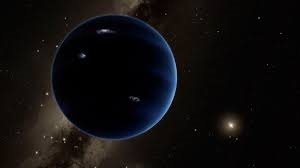A team has worked out possible physical properties for the proposed ninth planet
Astrophysicists have outlined what Planet Nine might be like – if indeed it exists.
In January, researchers suggested a large, additional planet might be lurking in the icy outer reaches of the Solar System.
Now, a team has worked out what they say are upper and lower limits on how big, bright and cold it might be.
Prof Mike Brown and Dr Konstantin Batygin made their case for the existence of a ninth planet in our Solar System orbiting far beyond even the dwarf world Pluto.
There are no direct observations of this much bigger object yet, but a search is now underway using the world’s largest telescopes.
This prompted the team, Prof Christoph Mordasini and Esther Linder, to use computer simulations to work out basic characteristics for the hypothetical ninth planet.
The astrophysicists assumed that Planet Nine was a smaller version of Uranus and Neptune – a small ice giant with an envelope of hydrogen and helium.
Using their planet evolution model, they calculated how parameters like the planetary radius or the brightness evolved over time since the Solar System formed 4.6 billion years ago.
Their results suggest that for a planet 10 times more massive than Earth (the estimate obtained by Brown and Batygin), it would have a diameter 7.5 times bigger than our planet’s. They also estimate that its temperature would be an icy -226C (-375F).
“With our study, candidate Planet Nine is now more than a simple point mass, it takes shape – having physical properties,” said Prof Mordasini.
Astronomers expect to discover Planet Nine about 700 times further out than the distance between the Earth and the Sun (over 100 billion km away). Here in the cold outer reaches of the Solar System, this ninth world would reflect very little sunlight.
Instead, most of its emission would be internal heat from the core. This would make Planet Nine more easily detectable at infrared wavelengths than through optical telescopes.
And the work might explain why telescopes have failed to detect the object so far.
Mordasini and Linder calculated the brightness of smaller and bigger planets on various orbits. They concluded that Planet Nine was probably too faint for past astronomical surveys to detect – especially if the object was near the farthest point of its orbit around the Sun.
But Nasa’s Wide-field Infrared Survey Explorer (Wise) space telescope might have spotted a planet with a mass equal to 50 Earth masses or more.
“This puts forward an interesting upper mass limit for the planet,” explained Ms Linder.
The team’s research assumes that Planet Nine formed from the same dense disk of dust and gas as the rest of our Solar System. But according to other researchers, Planet Nine could, in theory, have more exotic origins.
But other scientists – including Brown and Batygin – believe it’s perfectly possible for Planet Nine to have emerged from the same maelstrom that produced the other worlds in our cosmic neighbourhood.
Brown and Batygin have stated that the ninth planet could have been the core of a gas giant that was ejected from the inner solar system early in its formation.
Brown and Batygin’s initial evidence for Planet Nine was based on the alignments among the icy worlds that populate the Kuiper Belt region in the outer Solar System – and in particular two of its larger members, known as Sedna and 2012 VP113.
These alignments, they argued, were best explained by the existence of a hitherto unidentified large planet.
Then, last month, the Outer Solar System Origins Survey (Ossos) announced the discovery of a new Kuiper Belt Object (KBO) on a very eccentric orbit.
This world – given the provisional name uo3L91 – was, according to Prof Brown, “exactly where Planet Nine says it should be”.
Source: BBC
N.H.Kh

